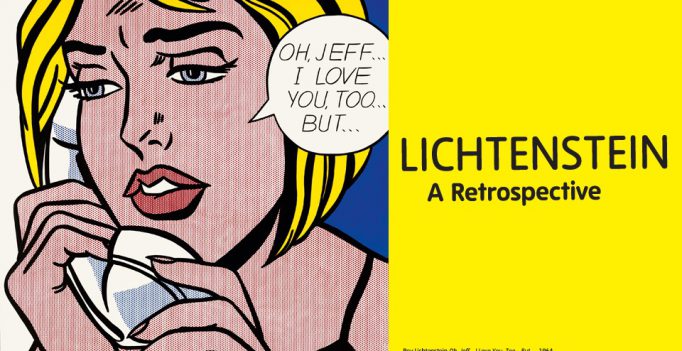A scintillating exhibition capturing a diverse collection of paintings and sculptures by the pop artist Roy Lichtenstein (1923-97) active between the 60s and 90s who reached prominence during the mid 60s and ever wider acclaim in the years to follow.
POP’s inception
Pop art is often asserted as Lichtenstein’s idea however the association is untrue. That honour, if a single mind could lay claim to it belongs to Richard Hamilton (1922-2011) and the iconic collage, ‘Just what is it that makes today’s homes so different so appealing’ (1956). Lichtenstein with some contemporaries (Andy Warhol (1922-87) and Jeff Koons (1955-present) enriched the movement and ensured its place in the cultural imaginary.
Catalytic, acclaimed & iconic
The piece that ignited Lichtenstein’s creativity was ‘Look Mickey’ 1961, a picture crudely copied from a Disney colour illustrated book about Mickey and Donold’s boating adventure. In contrast, the most acclaimed work for Lichtenstein cannot reside with one piece alone, but the much celebrated romantic and wartime period of comic book iconography, examples include Bratatat 1962 & Drowning Girl 1963 becoming indelible with the man, the times and the movement. They explored fully the ideas Ben-day dots, flattened colour planes and speech bubbles. If there was an iconic piece which is open for debate, Whaaam 1963 springs to mind in which an American fighter pilot is immortalised in the moment of victory fixed in time and space observing his enemy’s aircraft burst into flames.
Convention and style
The visual leitmotifs for Lichtenstein’s art were comic books, wide angles with a shallow depth of field. Detail was removed and the focus was given to subject matter nearly always close up or a mid shot. Planar divisions into fore, mid and background i.e. perspective were largely omitted. The materials were often acrylic and oil on canvas which gave the impression of print. The flattening out of the picture plane, lack of detail and simple compositions associated with early works suggest a uniform language however different periods betoken different conventions and styles. For example The Mirror Series, Still Lifes and artist pastiches showed clear differentiations of style.
Life and Times
The 1960s was a novel moment in time post World War II during which popular culture and consumerism attained a high point from which all branding, corporations have grown exponentially bigger and continue to grow. It was part of this expansive incursion into daily life which let the Big brands and Commercialism i.e. capitalism, celebrity lifestyle, available credit and affordability drive everyday behaviors towards a separated existence. Some POP artists critiqued this; Richard Hamilton, others – may have – secretly loathed it; Andy Warhol, others glorified it; Jeff Koons. But all accepted it as did society.
Legacy and extrapolations
Historically POP art is an extension of the ‘ready made’: found objects existing in society typically the mundane and uncelebrated materials of daily life. These could be anything from a skip to tin cans essentially anything already made. The artist composes and constructs with the network of associations post manufacture. Marcel Duchamp 1887-1968 with the signature piece, Piss Fountain 1917 is considered the originator of the style. The differences: ready mades are composed with real objects as opposed to derived from cultural media. Lichtenstein derived from the originals whereas Duchamp manipulated them directly leading one to a sculptural versus a pictorial style. Both questioned the value of objects, agency of the original and the artist as cultural broker.
OUTLINE
Excellent retrospective for all the family, vibrant, colourful and some fifty years on still feels fresh.
www.tate.org.uk/whats-on/tate-modern/exhibition/lichtenstein
written by: Colin Humphrey
